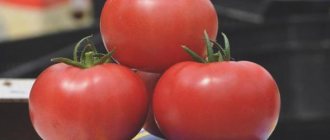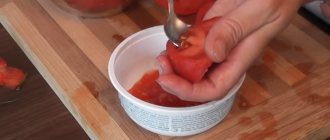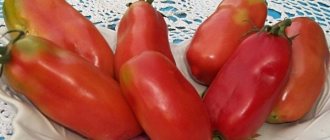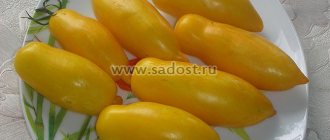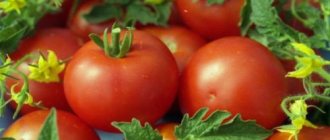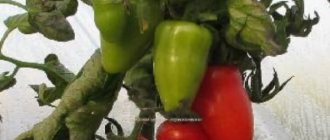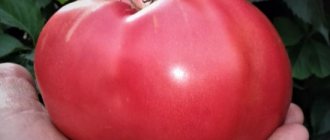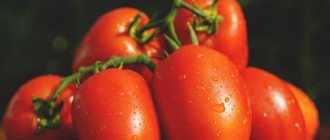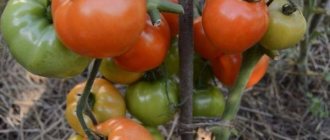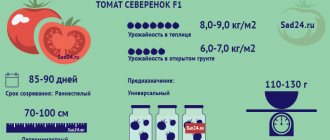Growing up in the north is not easy. But you can achieve productivity and get abundant, tasty tomatoes with Northern Beauty. For anyone who has plots in temperate latitudes, Siberia, or the Urals, this variety will be a great find.
| Height | Landing location | Ripening time | Fruit color | Fruit size | Origin | Fruit shape |
| Medium height | Greenhouse, Open ground | Mid-season | Reds | Average | Variety | Plum-shaped or oval |
Description of the Northern Queen tomato and its characteristics
Northern varieties, for example, the Northern Queen tomato, are highly valued by true gardening experts.
They have many advantages over ordinary tomatoes, which are intended mainly for growing in southern and central latitudes. The main advantage is that they are unpretentious to weather conditions and get sick very little. Moreover, the yield of northern tomatoes is often no worse than that of southern ones. However, it is worth considering that most of these tomatoes are of the determinate type. This indicates that the bush will grow small.
Description of tomato
Indeterminate, that is, tall tomatoes most often produce more yield, but they require more care, since they necessarily require gartering and shaping.
One of the brightest representatives of the northern varieties is the Northern Queen tomato. This is an excellent early-ripening tomato that produces excellent fruit in any summer. For this, he is loved not only in cold regions, but also in the central part of the country. You can often find bushes of this variety in gardens in southern latitudes.
The description provided by the manufacturer suggests that one of the main features of this variety is that it is ultra-early
For northern tomatoes this is very important, since they must have time to ripen and produce a harvest even in a short summer
They tolerate cool weather well, but to obtain maximum yield in the northern regions, it is recommended to grow the Northern Queen in greenhouses or greenhouses, which is also possible, given the small size of the plant. For this variety, seedling cultivation is recommended.
If you plant the seeds in time, you can get tasty fruits as early as the end of June. This becomes possible due to the fact that the Northern Queen is truly an ultra-early tomato, which produces a harvest within 85 days after planting the seeds for seedlings. Already sufficiently developed bushes are transplanted to a permanent place. Most often this happens on the 50th day.
This variety produces small bushes that do not need to be tied up. If the plant grows in open ground, it does not need to be rooted, but in a greenhouse it is still worth removing the shoot branches to increase productivity.
Caring for North Queen tomatoes is quite simple. Tomatoes must be watered moderately, and also do not forget about fertilizing. This is a very important point, because only high-quality fertilizer can guarantee a good fruit harvest in cold summer conditions and lack of sunlight.
Considering that the bushes are small, you should not expect excessive yields from them. But 3 kg from 1 bush can be harvested if planted correctly. Experts recommend planting tomatoes at a distance of about 40 cm from each other. In this case, from 1 m² it will be possible to harvest about 10 kg of tomatoes.
Fruit characteristics
The main characteristic why many people like the Northern Queen tomato is that the fruits can be harvested already at the beginning of summer. This is evidenced by numerous reviews from gardeners.
Description:
- These tomatoes are classified as salad varieties, so cold appetizers from them turn out simply great.
- They are also perfect for fresh consumption and canning: the juicy fruits make delicious sauces and lecho. In general, the North Queen tomato can be considered universal.
- The fruits have a flat-round shape.
- They are distinguished by their smoothness, bright color and increased juiciness.
- The main advantage of such tomatoes is that they do not crack due to their fairly thick skin. Not all salad tomato varieties can boast of this quality.
- During transportation or canning, such tomatoes do not lose their shape and do not burst.
The average weight of 1 fruit is 150 g. On the lower branch there will be larger tomatoes, and closer to the top they will be smaller.
Reviews about the tomato are extremely positive:
Yana, Arkhangelsk region: “Northern Queen is an excellent northern variety. Even with our cold summer we managed to grow beautiful tomatoes.”
Victoria, Ryazan: “Excellent tomatoes, small and dense. They look good in a jar and don’t crack when canned.”
Characteristics of the Northern Beauty tomato and description of the fruit
If a gardener is looking for not only a productive, but also a resistant variety, he should pay attention to the Northern Beauty tomato. The peculiarity of this tomato is not only the abundant amount of fruit, but also a very pleasant taste. That is why, among all the cool-resistant varieties, many gardeners choose the Northern Beauty.
It is believed that low-growing tomatoes produce less yield than tall ones. Moreover, many northern tomatoes are just like that. But Beauty in this case will be an exception, since this hybrid produces fairly tall bushes. They produce a large number of fruits, which delight the gardener for a long period.
Description of the variety
The Northern Beauty hybrid has many positive qualities. This is a mid-season tomato that produces a harvest already on the 115th day from the moment the seeds are sown for seedlings. Despite the fact that the hybrid is not early, it still produces high yields even in cool summers, since the variety is resistant to temperature changes.
- The bushes turn out to be quite tall.
- The characteristics with a description from the manufacturer indicate that this is a semi-determinate variety, that is, the plant has limited growth and does not need to be pinched. However, the size of the bush can be quite large.
- On average, the Northern Beauty grows up to 1.5 meters.
- The plant is green and lush.
- It requires obligatory garter to the support. Otherwise, the gardener risks losing part of the harvest due to broken trunks.
Tomatoes of this variety are considered high-yielding and, with proper agricultural technology, produce about 5 kg of delicious tomatoes from each bush. Moreover, if you form the plant correctly, then 4 bushes can be placed per 1 m². Thus, from 1 m² about 20 kg of delicious tomatoes come out.
Formation means the removal of excess branches, which are called stepchildren. They will not bear fruit, but they draw juices from the plant, which prevents the fruit from developing. Therefore, with properly formed plants, the yield increases significantly.
You can also increase the number of fruits with the help of fertilizer. The Northern Beauty variety is very fond of both mineral and natural fertilizers. We should not forget about the need to weed and loosen the soil. As for watering, it should be moderate.
If the humidity is too high, the bushes will begin to suffer, including fungal diseases. Moreover, for preventive purposes it is worth additionally using drugs against diseases characteristic of nightshades. Northern beauty is considered a hardy variety, but additional protection against diseases will not be superfluous.
Fruit characteristics
One of the main positive qualities of tomatoes of this variety is the pleasant taste of tomatoes. They are sweet, very soft and have thin skin, so they are perfect for salads. The northern beauty has not only excellent taste, but also a pronounced aroma.
But the softness of the fruits will also be a disadvantage, since because of this they are not very suitable for whole canning, as evidenced by the reviews of many housewives. However, some of them still use Northern Beauty tomatoes to make sauces and juices.
They are elongated in shape and have a sharp nose. The weight of the fruit varies, but on average it is 100 g. Larger tomatoes are formed on the lower clusters, and rather small fruits grow higher, the weight of which can be only 50 g.
When unripe, tomatoes will be light green. But as they mature, they begin to turn pink from the tip. The fruits can be collected already at the stage when a yellowish spot remains near the stalk. In this state, the tomatoes can already be considered ready to eat. The number of fruits depends on how well the tomatoes are cared for.
The best varieties of tomatoes
There are must-have varieties that I always plant every year. I like them not only for their taste and unpretentiousness, but also for the way they look on the bush. I’ll paraphrase one bearded joke: “I don’t really like tomatoes... But the process itself...”. I love going into the greenhouse and admiring the tomato plantations. And I don’t hesitate to show off my particularly spectacular huge tomatoes to my neighbors, and then post photos on the forum. It’s a shame to hide it – we all love it!
The following varieties are among the favorites also because they do not need to be fanatically cultivated and shaped. And they will always give a harvest: small, large, and a lot, depending on the variety and what I grow them for - for salads, for preparations, or, the smallest and sweetest ones, so that “like seeds, they click.” .
The “Rocket” variety is suitable for both greenhouses and open ground. The fruits are identical in shape and sweet. We love to eat them by the handful. Look good in blanks. The bush requires garter, despite the fact that the package says the opposite. This is because a lot of fruits grow, and the bush bends from the weight. Its height in open ground is about 40 cm, and in a greenhouse it can reach up to 60 cm. This is a mid-season variety; it does not need to be pinched.
Rice. 1. “Rocket” matures smoothly and is well stored in both technical and biological maturity.
Rice. 2. There is almost no need to pin the “Big Man” wrist.
Rice. 3. It ripens in batches, gradually, which is very convenient.
Among the vigorous-growing tomatoes with large fruits, I singled out the “Red Giant” variety. This amateur variety was bred by simple gardeners. Despite the fact that it grows a lot of leaves, it does not have to be pruned too often. The fruits on the lower tiers are the largest. If I had not been lazy and plucked out the inflorescences, leaving no more than 3-4 in the brush, the fruits would have been even larger. It is fleshy inside and contains few seeds.
Rice. 4. “Red Giant” in mid-July.
Rice. 5. You can take your own seeds, but the fruit must ripen on the bush and come from the second cluster from the bottom.
Rice. 6. The fruits are slightly ribbed, quite transportable, there is never a yellow-pink top from unbalanced care, as in pink-fruited varieties.
Rice. 7. Both the side of the stalk and the reverse side always have a marketable appearance.
Rice. 8. The only drawback of the “Red Giant” is that the largest fruits require a garter.
However, almost all large-fruited tomatoes require additional tying of the brushes. Except for my next favorite, Bull's Heart. I also always grow it year after year, as my grandmother advised me. “He will never let you down!” - she said, and every year I am convinced of this. Even if I took my own seeds and not factory ones, “Bull’s Heart” invariably bears fruit and does not require pinching at all, although it is vigorous. Somehow I didn’t have enough space in the greenhouse, and one bush of “Bull’s Heart” grew on the street without shelter. It grew to 1 m instead of 140-150 cm in the greenhouse, but still pleased me.
Rice. 9. The hands grow in such a way that they do not need to be additionally secured with a garter to prevent them from falling.
Rice. 10. There is one feature of the “Bull’s Heart” - a predisposition to the formation of such gnarled fruits.
Therefore, if you see a bud or flower that is too large, feel free to cut it with scissors, it will still take a long time to ripen, even though it will be large, the skin will be hard and gray, you cannot take seeds from it.
Rice. 11. But the bulk of the “Bull’s Heart” fruits are very beautiful, tasty and fleshy. By the way, this variety comes in both orange and red.
Tall tomatoes for the greenhouse
I definitely plant the listed varieties, but there are also some that I just liked, and I periodically grow them in the greenhouse, but I have not become a fan of them. Of the indeterminates, I like the raceme varieties the most. Again, this is primarily because they look beautiful on the bush. There are only three varieties, and each has a special reason to grow it.
“Intuition F1” is a mid-season hybrid, but I would classify it as a late-season hybrid. Not only does it reach harvest ripeness only by mid-August, but biological maturity also comes quite late. Some specimens of these tomatoes ripen even until the end of October. But, on the other hand, this is convenient because as a result, we have our own fresh tomatoes at home for a very long time. That's why I sow it in February.
Rice. 12. Photo from the end of July, but the fruits have not yet begun to ripen.
But “Intuition F1” is very easy. This hybrid is great for freezing for future use. In winter, I make pizza and frittata with them, as they do not defrost like porridge, but retain their meatiness well when cut.
Rice. 13. The fruits are all smooth and beautiful.
Rice. 14. In this form, I send “Intuition F1” to deep freeze.
“Scarlet Candles” is a cluster variety, mid-season. They don’t have a special taste, but what a shape! Looks impressive in preparations with cucumbers. However, this is why I grow them. It’s nice to admire such a jar later in the winter.
Rice. 15. The length of “Scarlet Candles” is almost like pickling cucumbers.
Rice. 16. “Scarlet candles” look neat, they all have a characteristic “spout”.
“De Barao” is quite late-ripening; I sow it earlier than the bulk of tomatoes. I really like it in preparations, it does not crack and is very tasty, both fresh and pickled.
Rice. 17. "De Barao" is resistant to disease. I always plant it on the north side, tying it above the entrance to the greenhouse, because it is very tall, and the upper tier ripens even in the last ten days of August, despite the first cold nights.
Rice. 18. The fruits are beautiful, all as one.
I have tried a great variety of salad varieties, I still want to find the most delicious one. Of the unusually colored tomatoes, I really like the taste of Malachite Box and Black Prince . Both are tall and require pinching, gartering, and formation into 1-2 stems, but the effort is worth it, the fruits are magnificent. “Black Prince” is dark burgundy when fully ripe.
Rice. 19. “Malachite box” in biological maturity – green.
Rice. 20. All these “Malachite Box” tomatoes are already ripe, although in appearance they seem unripe.
The yellow giants are not inferior in taste, of which the most fleshy and tasty for me are “Yellow Truffle” - of an unusual shape, “Persimmon” - indeed, the pulp is cut like the fruit of the same name, “Golden King” and sweet as a melon, “ Golden Bull" . “Golden Heart” and “Altai Yellow” were less impressive But it should be noted that the shelf life of yellow tomatoes is inferior to red ones. From salad reds, I grew “King of Large”, “Cardinal”, “Canary”, “Bear’s Paw”, “Mazarin”, “Altai Red” . What can I say about them - they are all equal, as if they were selected. It tires them to constantly tug and tie them up. One good thing is that they are large.
Read also: What is the temperature in a house without heating in winter?
Rice. 21. Everyone looks the same on the bush. This is Cardinal.
Rice. 22. “Cardinal” is well kept.
Rice. 24. In the foreground is “Mazarin”. It differs only in shape, in taste - like all other red-fruited ones.
Rice. 25. “Altai Reds”, however, can be praised for their friendly maturation.
Separately, I would like to mention the pink-fruited tomatoes “Miracle of the Earth”. If you are lucky with the summer and it is not very hot, then you can get a good harvest from this variety.
Rice. 26. “Miracle of the Earth” are also tall.
But, if there is not very good ventilation in the greenhouse, then this variety will give a characteristic light yellow border, I don’t like it, and I cut it off before use.
Rice. 27. “Miracle of the Earth” - on the right. They are the same size as the Red Giant on the left.
Separately, it should be said about tall cherry tomatoes, for example, “Chio-chio-san”, “Sweet Cherry F1” and others. Yes, many of them are sweet, they look elegant both in the greenhouse and in pickles, but many of them are thrown away and require careful care. No matter how much I refuse to plant them, I still “break down”, I really want to admire the brushes.
Rice. 28. “Red date” is, of course, delicious.
Rice. 29. “Goldilocks” also tastes good if you resist and don’t eat it half-ripe - and it can be eaten even half-ripe.
Description and characteristics of the tomato variety Northern Malyutka
The Northern Baby tomato was specially bred for regions with cool climates where summers are very short. Tomatoes are not afraid of cold; they can be grown in open ground. The variety is characterized by good productivity. You won't have to wait long for the first fruits; they will appear in early July.
Characteristics of the variety
Northern baby is a variety of early-ripening tomatoes. The fruits have time to grow and ripen even in cool, short summer conditions. The species was specially developed for cultivation in Siberia and the Urals.
The bushes of the plant are low, the foliage is neat, with medium-sized leaves, the plant growth does not exceed 40 cm. This fact allows you to start growing tomatoes in small summer cottages, where every square meter counts. The tomato bush is lush, spreading, it does not require pinching, the leaves are of normal size, light green in color.
The general characteristics of the tomato variety can be expressed in the following points:
- determinate plant;
- short stature;
- spreading bushes;
- simple inflorescence;
- smooth, round fruit;
- small fruit sizes;
- simple inflorescence.
With proper care, you can get 1 kilogram of harvest from one bush; from one square meter you can harvest up to three kilograms of tomatoes per season.
Northern baby is a variety of tomatoes that are small in size. Their fruits have a round shape, begin to turn red during ripening, and at the moment they reach maturity they acquire a uniform dark red color. The weight of one tomato can range from 45 to 60 grams.
The tomatoes are juicy, they have a pleasant sweet taste with a sour tint. The skin is strong, the fruits are strong and do not crack. Vegetables are used to make salads and are consumed both fresh and canned. Tomatoes of the presented variety can be canned whole. Tomatoes withstand transportation well, they retain their appearance on the road and do not get crushed.
Advantages
Northern baby tomatoes have many advantages. These tomatoes are good to grow in small areas. Even a beginner can care for this vegetable crop, since tomatoes of this variety do not require special care; it is enough to follow the basic rules. Among other advantages, I would especially like to note the following points:
- the plant is not afraid of cold and sudden temperature changes;
- has good early yield;
- bears fruit amicably and abundantly;
- the first tomatoes begin to appear after 80 days;
- the variety does not require care;
- can be grown in open ground;
- not susceptible to various diseases, bushes do not develop blossom end or root rot;
- there is no need to tie up the bushes, since they are small and will not break.
The main advantage of Northern Malyutka tomatoes is their early fruiting. And yet, the first ten days will give 40% of the total harvest as a whole.
Growing tomatoes
The northern baby is unpretentious. But in order to get a good harvest, you will need to follow some rules. Cultivation is carried out taking into account the following factors:
- seeds for seedlings begin to be sown in mid-April;
- one seed is buried at a distance of one and a half centimeters from the surface;
- the soil temperature for planting seeds should be about 20 degrees;
- seedlings are planted in slightly acidic soil;
- bushes are planted according to a 60 X 60 cm pattern.
Caring for the plant involves regular, abundant watering. Tomatoes love moisture, but they should not be overwatered. Once a week will be enough. Watering is carried out with warm water. It is better to do this in the evening, when the sun has set. Fertilizers can be added to water for irrigation.
Before you start growing the Northern Malyutka variety, you need to find out more about it, read the description, and learn about the features of care. With the right approach to business, you can get a good harvest of delicious tomatoes.
Features of care
The Northern Beauty tomato requires special attention to its care and compliance with certain rules:
- Regular, moderate watering.
It is necessary to irrigate the soil as its top layer dries. - Timely removal of weeds.
Weeds can acidify the soil. In addition, they can become a source of spread of parasites. - Loosening the soil.
Loose soil provides free access to air and moisture. - Introduction of fertilizers.
To feed tomatoes, mineral or organic fertilizers are used, which are introduced according to the instructions. - Treatment with biostimulants.
To improve plant growth, it is permissible to use biogrowth stimulants. - Garter to support.
Bushes of this variety reach 1.5 m in height and need to be tied to a support. Keeping the plant upright ensures its health and proper distribution of nutrients. - Timely harvesting.
Ripe tomatoes take a lot of energy from the plant, which negatively affects its general condition and ability to feed unripe fruits.
Compliance with the rules of care guarantees not only good fruiting, but also high taste characteristics of the fruit.
The Northern Beauty variety is distributed throughout Russia and beyond. Its features ensured popularity among experienced summer residents, and its taste characteristics conquered many people.
tomato Sugar Nastasya - description and characteristics of the variety
Description and characteristics of the tomato variety Lorraine beauty
If we classify tomatoes by application, we can distinguish four large groups - salad, processed, universal, decorative and gift - with specific and unusual fruits. One of the brightest representatives of the latter is the Lorraine beauty tomato. Their main purpose is to decorate the table.
Fruit characteristics
The Lorraine beauty tomato is an elegant large, ribbed, rounded fruit, flattened at the top. Outwardly they look like a closed flower with wide petals. The color of ripe tomatoes is bright scarlet. Weight is 200-350 grams, with proper agricultural technology it can reach half a kilogram.
The inside is multi-chambered, hollow, almost without seeds. The taste is sweetish with sourness. Suitable only for fresh consumption - slicing or stuffing looks impressive on the table. Dense, resistant to cracking. They are stored for a long time. They ripen well when picked brown.
Properties of the variety
The tomato is of American origin, more precisely of US selection. Tomatoes are of indeterminate type, with a height of 1.5 to 2 meters. The average late ripening period is 110-120 days. It is grown both in greenhouses and open ground. Self-pollinating. Productivity is low - no more than 3-4 kg per bush. Under unfavorable weather conditions, you can generally get 2-3 tomatoes.
The characteristics of resistance to viral and fungal diseases are as follows: resistant to Fusarium wilt, gray leaf spot, tobacco mosaic, Alternaria stem cancer, verticillium, cladosporiosis, nematode. Not resistant to root and white rot.
The bush is not standard - the stems are thin in constitution, large, slightly corrugated leaves. You can also add to the description of the variety that due to its specificity, it is not grown in agriculture on an industrial scale. This is a tomato for amateur gardeners and collectors of unusual plants.
Features of cultivation
Tomatoes of the Lorraine Beauty variety are no different in cultivation technology from most classic varieties:
- sowing seeds - obtaining seedlings.
- picking.
- transplanting.
- cultivation - watering, fertilizing, garter formation.
- harvesting.
Sowing seeds for seedlings for open ground, taking into account the climate zone, is carried out no earlier than two months before the onset of stable warm weather. After 3-4 weeks, in the phase of 2-3 true leaves, they peak. They are planted approximately 30 days after picking. If warm weather has not yet established itself, the seedlings should be “tempered” - treated with the drug “Tur” or another growth regulator to avoid overgrowth.
The planting pattern is 60 x 50. The interval along the rows is 60 cm, between plants 45-50. Due to its resistance to cracking, the beauty does not require strict adherence to the watering regime, but the soil should not be allowed to dry out too much.
Selection of fertilizers according to the classic P-NK scheme. During the development period, the complex contains a large percentage of nitrogen, during flowering and ovary - phosphorus, and when fruits ripen, potassium is needed. To prevent blossom end rot, periodically give Ca, that is, calcium nitrate. Fruiting continues as long as weather conditions permit. With the onset of cold weather, the still green fruits will grow well at room temperature.
Lorraine beauty yellow
In addition to red, there is also a yellow variety with ribbed, corrugated fruits. In terms of general characteristics, these two tomatoes are similar - both are indeterminate in the average ripening period. The color of the tomato is bright yellow-orange. The cutting looks very beautiful together with red ones, very similar to flowers.
Advantages and disadvantages of the variety
The advantages include the following:
- Lorraine beauty, a spectacular, unusual-looking tomato reminiscent of dahlia flowers;
- high taste qualities;
- resistant to most diseases;
- unpretentious, easy to grow;
- It is possible to form a bush into two trunks.
The disadvantage is the low yield, which is highly dependent on weather conditions. Due to the long ripening period, in the north, tomatoes are cultivated only in greenhouses.
Sowing seedlings
Two months before the expected date of planting seedlings in open ground, the seeds are sown in the ground. That is, if you plan to plant seedlings in the second half of May, then the seeds are sown in the second half of March. If the seedlings are planted in early June, then the seeds are sown in early April. These terms should be applied to the climatic characteristics of a particular region.
Important! The main criteria for planting seedlings is stable warming of the soil and air, avoiding the last frost.
Before sowing, the soil must be watered. The planting depth should be no more than 2 cm, otherwise with further watering the water will “draw” the seeds deep into the light soil. To create the optimal temperature for seedlings, the pots are covered with film. After the sprouts appear, it is removed.
Seedling care
Caring for seedlings is quite simple, because it is enough to keep them warm, in a lighted room or greenhouse, periodically moistening the soil. Tomato seedlings are picked when the second true leaf appears - the seedlings are transplanted into separate pots and buried slightly into the ground. The seedlings will be ready in 60 days, so there is no need to delay planting them in the ground.
Landing in the ground
The area must be prepared in advance for the beds - weeded and loosened; it is best to plant during the late wind, in order to avoid exposure to the scorching sun on bushes that have not yet taken root.
Seedlings of the Spring of the North hybrid are planted at the rate of 4 bushes per square meter of land. Holes for planting are made 10-12 cm deep, fertilized with a glass of ash, humus, or sprinkled with 5 g of superphosphate. The seedling is buried in soil spilled with warm water and buried. After planting all the bushes, the ground is mulched with sawdust, straw or hay.
Northern tomatoes
This year our summer was rainy and cold. But for tomatoes to grow around the clock, the night temperature must not be lower than +18°C (which happens very rarely!). That is why southern varieties of tomatoes cannot be grown in our region. We need very early, high-yielding and unpretentious varieties with a friendly yield. These are the tomatoes I grow on my plot. In fact, only such varieties become a lucky find for those gardeners who want to receive ripe tomato fruits as early as July. I will describe the most promising tomato varieties that I tested on my plot. These varieties can be grown both in open ground and under film. If you grow them in a small greenhouse under a film cover, you can get an earlier harvest. The Low-growing super-early variety is a tomato with an extremely early ripening period (the fruits ripen from July), with a friendly yield, and does not ripen. The plant is short, no more than 50-60 cm high. Mature fruits are red, weighing up to 100 g. The photo shows tomatoes of this variety grown in a film greenhouse. Variety Low-growing early-1. The plant is 70-80 cm high, does not spread. The fruits are red, weighing up to 100 g, yield up to 5 kg per bush. Another very early variety is Dana. This is also a low (up to 1 m) plant and does not climb. Tomatoes ripen well both under film and in open ground. The fruits weigh up to 100 g, are very tasty, suitable for both processing and fresh consumption. Low-growing large-fruited is one of the large-fruited varieties that grows in my garden. The plant is about 1 m high and does not spread. The fruits are red, weighing up to 500 g. As is known, a high yield of any vegetables can be obtained only from high-quality seeds and by maintaining competent agricultural technology during the entire growing season of the plants. Therefore, I want to share the secrets of my many years of experience. First of all, I came to the conclusion: in order to have full-fledged tomato seedlings, you need to sow twice as many seeds as you need. You will not put all the seedlings in a row into separate cups, but only well-developed plants. Only such seedlings can produce high yields in the future. Crop rotation must be observed on the site. Tomatoes cannot be grown in one place for more than three years in a row, otherwise the plants will get sick due to infection accumulated in the soil. Our soils are poor in nutrients. To obtain high yields, it is necessary to apply organic and mineral fertilizers. Every spring, when digging up a plot for tomatoes, it is advisable to add 1 square meter. m 10-15 kg of humus (rotted horse or cow manure) and a liter jar of ash obtained from deciduous trees. When planting tomatoes directly into the hole, also add a matchbox of sifted ash, having previously mixed it with the soil. Over the summer, I do three root fertilizing with “Sudarushka”, three foliar fertilizing with “Ideal” and foliar fertilizing with boron-magnesium microelements. The varieties I grow are quite resistant to late blight, but still, at the first signs of the disease, it is necessary to immediately spray the plants. I prefer to treat tomatoes in a film greenhouse and in open ground three times a season with Hom or Oksikhom. Plants should be treated against late blight only in dry weather. It is advisable that there should be no rain for at least a day so that the drug can “fix” itself. Spraying requires a fine spray. All leaves, fruits and ovaries must be covered with a protective film, otherwise there is no guarantee that late blight will not develop. If you use a broom instead of a sprayer, there will be no excellent effect. Now a few words about the greenhouse where you are going to grow tomatoes. It must be constantly ventilated. During flowering of tomatoes, the temperature should not exceed +26 ° C, since at higher temperatures the pollen of the plants becomes sterile, therefore, pollination will not occur. But if all pollination is poor, the plants need to be treated with the Ovary preparation.
I hope that if you apply my technology on your plots when growing the named varieties of tomatoes, you will definitely have a harvest and get well-ripened, as they say, “standing” tomatoes. If you want to have your own seeds, then grow all varieties separately from each other, this is the only way to maintain purity.
Video: Northern Beauty tomatoes
Variety characteristics:
Properties of the Northern Beauty variety:
Recommended region on the map:
Information on the admission of Tomato Northern Beauty from the Register of the State Variety Commission of the Russian Federation
Application for admission No. 34031, registered 2000-03-27. The Tomato variety Northern Beauty was included in the register of those approved in 2006. Approved for use in regions: All regions.
Sowing rules
Sowing work should be carried out 65-70 days before the intended plant transplantation. In order to get the healthiest plant possible, you need to take the choice of seed seriously. The soil must also be of high quality. Therefore, it is worth visiting a garden store to buy the best soil mixture.
Tomatoes of the Red large variety should germinate in 3-5 days after sowing
It is important to control the air temperature so that it does not fall below 20 degrees. Low temperature prevents crop germination
Temperatures above 28 degrees act in the same way.
While the tomatoes are hatching, the farmer must maintain soil moisture by periodically irrigating. Lighting does not play a role at this stage. It is attached after the sprouts have completely pecked.
The light should be intense and affect young plants for 6-10 hours a day. This will allow the tomatoes to grow vertically.
Advice! Before transplanting the bushes, you can remove a couple of lower leaves. This will allow the seedlings to be planted deeper and the tomatoes to develop well even in drought conditions. This allows air to circulate better under the plants and affects the development of the root system. A strong tomato root is the key to the plant's durability.
Large Red tomatoes should be planted in an area that is well lit. The soil is thoroughly fertilized, and a complex fertilizer labeled 10-8-8 is additionally applied to each bush. The first number indicates the nitrogen content, which is extremely important at the first stage of tomato development after transplantation.
Description of the Northern Beauty tomato variety, its cultivation and care
When selecting tomato varieties for canning, gardeners should pay attention to the Northern Beauty tomato. Among the abundance of ordinary and hybrid species, tomatoes of this type stand out for their high yield and excellent taste.
What else is remarkable about the variety?
Description of the variety
Northern beauty is a mid-season indeterminate variety. The height of the bush is 140–150 cm. From the moment of seed germination to the ripening of the fruit, 118–120 days pass. The plants are covered with medium-sized leaves of the appropriate shape for tomatoes. The color of the stem and leaves is green.
Fruit characteristics:
- Unripe tomatoes are light green, the area around the stalk is dark green.
- Upon reaching technical maturity, the fruit turns deep pink.
- Inside the tomatoes, covered with smooth thin skin, there are 5-6 seed chambers.
- The pulp is dense and juicy.
- The taste is distinctly sweet.
- The shape of the fruit is elongated cream with a cone-shaped pointed tip.
- 5–6 tomatoes are formed from the inflorescence.
The weight of a tomato ranges from 60 to 120 g. Thanks to the fleshy core, the fruit is perfect for preparing canned whole fruits and eating fresh. Subject to the correct watering and fertilizing scheme, as well as normal weather conditions, the plant yield is 4.1 kg per 1 sq. m. beds.
The Northern Beauty tomato variety is resistant to dangerous diseases such as fusarium and TMV. The bushes tolerate long droughts and cold snaps well.
In view of these features, tomatoes grow well throughout Russia, including the northern regions. Tomatoes of this variety are suitable for growing in greenhouses and open ground.
Features of cultivation and care
In order for all the characteristics to manifest itself in practice, planting and subsequent manipulations must be carried out according to the established plan. To obtain seedlings, seeds are sown in seedling boxes 50–55 days before planting in the garden. To speed up seed germination, cover the container with plastic film or glass.
Until the sprouts appear, the cover is periodically removed. If you keep the crops covered, growing delicious tomatoes will be a disaster: the soil will become moldy and the seeds will not germinate.
Seeds are sown in furrows to a depth of 1 cm. After germination, excess plants are removed or planted in separate cups after the formation of 2-3 true leaves. Young plants are planted in a permanent place after the formation of 5–6 true leaves. Plant seedlings in cloudy weather or in the evening.
According to the description of the variety, the height of the bushes is about 1.5 meters. Plants of such large growth are usually tied to supports. Being in an upright position, the plant gets sick less often, since the fruits do not come into contact with the soil, and the bushes are well lit and ventilated. In addition, thanks to the correct distribution of nutrients, formed bushes bear fruit better than their creeping, unkempt counterparts.
Caring for tomatoes completely coincides with the generally accepted care for all types of vegetable crops. The bushes are regularly watered and fed with organic fertilizers.
Have you grown a Northern Beauty tomato? What are the advantages and disadvantages of this variety? Your opinion will help those who still have doubts make their choice, because reviews based on life experience are much more important than stereotyped characteristics.
Plant etiolation
To achieve a high level of fruiting, it is necessary to observe the nuances during germination, transplantation and further care.
Growing the Northern Madonna Raphael variety begins with the germination of seed material. Agronomists recommend starting this process 55 days before the planned transplanting of young plants into the garden. Germinating Northern Beauty seeds has its own characteristics:
- Fumigation of seeds.
Before planting seed material in containers with soil, it is necessary to disinfect them. To do this, use a weak solution of manganese. - Preparing the container and soil.
Experienced summer residents advise choosing separate, small containers. This will facilitate the subsequent process of transplanting seedlings to the garden bed. It is recommended to choose (make nutritious, loose soil. - Sowing.
The seeds are placed in containers filled with soil, deepening them no more than 1 cm. - Greenhouse conditions.
Experienced gardeners recommend lining the container with film to achieve a greenhouse effect. To prevent soil mold, it is inevitable to remove the film periodically. - Picking.
After the appearance of 2-3 true leaves, the seedlings should dive.
The readiness of seedlings for transplantation to a permanent place of growth is indicated by the appearance of 5-6 true leaves. Experienced vegetable growers advise replanting in the evening or on cloudy days to prevent severe sunburn on the top of the leaves, which can lead to the death of the plant.
Growing and care
- Tomatoes of the Lorraine beauty variety love warmth.
In bad weather conditions it can produce below average yields. This becomes another reason for growing in greenhouses, where the temperature can be artificially increased. Tomatoes Lorraine beauty - Growing seedlings is standard.
Picking of seedlings is carried out after the appearance of 2-3 true leaves. Nutrient mixtures should be used and fertilizing should be carried out so that the root system has time to strengthen before planting in the ground. Ripening tomato - Tomato fruits are large and heavy, so you should additionally tie up not only the plant itself, but also strengthen the brushes. When growing outdoors, you should choose places where the wind force is minimal. Otherwise, strong winds may break the plant.
We invite you to familiarize yourself with: The best varieties of perennial onions
Beauty Lorraine tomatoes are grown in open ground. If weather conditions do not allow, the plant is planted in a greenhouse: there it also bears fruit well. Lorraine beauty tomato seeds are sown in early spring.
The seedlings are transplanted into open ground after 60 days to a depth of 1 cm. A distance of about half a meter is left between them. A little later, the bushes are tied to strong stakes. Side shoots and lower leaves are regularly removed from tomatoes.
Growing a plant
To achieve a high level of fruiting, it is necessary to observe all the nuances during germination, replanting and further care.
Growing the Northern Beauty variety begins with germination of seed material. Agronomists recommend starting this process 55 days before the planned transplanting of young plants into the garden bed. Germinating Northern Beauty seeds has its own characteristics:
- Seed disinfection.
Before planting seed material in containers with soil, it is necessary to disinfect them. To do this, use a weak solution of manganese. - Preparing the container and soil.
Experienced summer residents advise choosing separate, small containers. This will facilitate the subsequent process of transplanting seedlings to the garden bed. It is recommended to choose nutritious, loose soil. - Sowing.
Seeds are placed in containers filled with soil, deepening them no more than 1 cm. - Greenhouse conditions.
Experienced gardeners recommend covering the container with film to achieve a greenhouse effect. To prevent soil mold, the film must be removed periodically. - Picking.
After 2-3 true leaves appear, the seedlings need to be pricked.
The readiness of seedlings for transplantation to a permanent place of growth is indicated by the appearance of 5-6 true leaves. Experienced vegetable growers advise replanting in the evening or on cloudy days to prevent severe sunburn on the leaves, which can lead to the death of the plant.
tomato Heart of a Beauty - description and characteristics of the variety
Description of the variety
Katyusha is a hybrid domestic variety that appeared as a result of crossing other varieties. Year of creation: 2007. The tomato has excellent taste and ease of care.
Distinctive features
Katyusha ripens within 85-100 days from the moment of sowing. The crop is grown both in open ground and in greenhouse conditions. In a greenhouse, ripening time is reduced to 70-80 days.
The hybrid is resistant to drought and heat, while it tolerates high air humidity and rainy summers.
The bushes of the variety are determinate - that is, they are limited in growth. The maximum height of one bush in open ground is about 80 cm, in a greenhouse - 1.5 m. The foliage is average, the leaves are dark green, small, and have an oval-pointed shape.
Fruit characteristics
The berries of Northern Beauty are elongated, with a pointed tip characteristic of the variety.
Ripe tomatoes have a rich, pink color, while unripe ones have a light shade of green with darkening at the base. From one inflorescence, up to 6 pieces of fruits are formed, which have 6 chambers with seeds. Their pulp has a dense structure.
The taste of the fruit is very high. The sweetness of the pulp distinguishes this variety from many similar ones, and indicates a high sugar content.
Housewives use Northern Beauty tomatoes for canning whole fruits, preparing juices, salads, first and second courses.
tomato Silver spruce - description and characteristics of the variety
